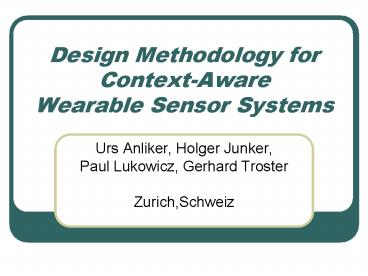Design Methodology for ContextAware Wearable Sensor Systems PowerPoint PPT Presentation
1 / 20
Title: Design Methodology for ContextAware Wearable Sensor Systems
1
Design Methodology for Context-Aware Wearable
Sensor Systems
- Urs Anliker, Holger Junker,
- Paul Lukowicz, Gerhard Troster
- Zurich,Schweiz
2
Introduction
- Optimization problem where to put the sensors,
how to organize the system - Traditional way trial and error approaches
- Formalize the optimization problem and pave the
way towards an automated system design process.
3
? previous work A systematic approach to the
design of distributed wearable systems. ? 3
components - architecture model -
problem specification - exploration
environment
4
Architecture Model
- Generic model
- A set of computing modules distributed over the
users body - Module
- Devices processors, sensors
- Communication channel interface IO interface
- Inter-module communication physical channel
- Problem specific model
- a set of constraints on following from problem
specification - system topology
- module resource set
- task resource set
5
Problem Specification(cont.)
- Usage profile
- Workload characteristics of the wearable system
- Task
- Self-contained unit
- Input data
- Computational load
- Use instruction mixture
- Output data
- Application
- Scenario
- Assigning 2 timing parameters
- Repetition frequency R
- Maximal latency Dmax
6
Problem Specification(cont.)
- Information flow
- A set of body locations to each I/O related task
of the usage profile specification. - Physical constraints
- The devices size, weight
- Power consumption
- Power weight vector wp
7
Problem Specification
- Hardware resources
- A set of computation and communication channel
devices available for the design. - Computing devices
- 2 characteristics of
- Execution speed
- Energy consumption per cycle
- Operation modes sleep, idle, execution
- Communication channel
- 4 operation states transmitting, receiving,
idle, standby - 2 modes continuous mode, burst mode
8
Exploration Environment
- 3 optimization criteria
- Functionality
- By timing constraints R and Dmax
- Battery Lifetime
- Wearability
- The sum of the abstract wearability factors of
all allocated resources for a specific module m
at a given location p.
9
Extensions to the Model(cont.)
- Context
- 2 parameters
- Update rate
- Minimum classification performance
- Context lt-gt application
- Feature
- Mathematical function, which preprocesses raw
sensor data. - Feature lt-gt task
- For data reduction, dataout ? datain
10
Extensions to the Model(cont.)
- Sensor
- Generates data at a sampling frequency (fsample)
with a specific resolution (res). - 2 power states sampling (Psample), idle (Pidle)
- Be specified in the hardware resource
specifications
11
Extensions to the Model
- Mapping and Binding
- Introduce context resource set and feature
resource set - Sensors are used as data source
12
Objectives(cont.)
- Power consumption
- Sensor load(SLoad)
frep update rate
13
Objectives(cont.)
- Classification performance
- Recognition accuracy
- Mutual information
- If MI(XY) 0, then X, Y is independent
feature F
class variable C
14
Objectives
- Error probability (Fanos inequality)
- The error probability is decreased if MI(CF)
gets larger.
of classes
15
Case Study
Force sensitive resistors
???
16
(No Transcript)
17
(No Transcript)
18
Conclusion and Future Work
- Describing a methodology designed to formalize
and automate the choice and placement of sensors
and the selection of features for wearable
context sensitive systems. - Future work Apply it to more complex case
studies and recognition tasks
19
Contribution
- Systematic framework for sensor selection based
on power consumption and classification
performance for wearable computing applications. - Taking classification performance via mutual
information for computation and communication.
20
Q A
- Thank you !!

